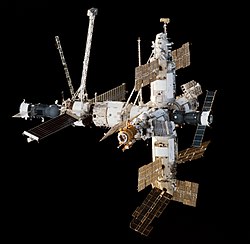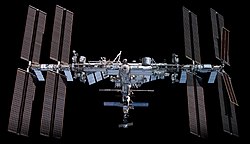Space station
A space station is a artificial satellite in space that people can live at. All past and current space stations have been in low Earth orbit. Space stations can dock with other spacecraft. This allows transferring cargo and people. At present the International Space Station is the only space station in orbit. The first space station was Salyut 1. Prior stations were the seven Salyut stations, Skylab, Mir and the two Tiangong stations.[1] The Chinese Space Station is planned for the future.[2]
Space stations are used to learn about how being in space for a long time affects the human body. They also are a place for science experiments and research.[3] Space stations have been designed for more than one crew. Each crew member may stay aboard the station for weeks or months, and then is replaced by others. Some have spent more than one year at a time on a space station. This includes Vladimir Titov, Musa Manarov, Sergei Avdeyev and Valeriy Polyakov aboard Mir.[4]
List of successful stations
The below list is of stations that made it to orbit and had at least one crew visit them. There have also been a few stations that have failed or were for testing. Those are not included on this list.
| Name | Country | Launched | Burned up in atmosphere |
Days in orbit |
Days with people on board |
Crew and visitors (total) |
Visiting crewed spacecraft |
Visiting uncrewed spacecraft |
Mass kg |
|---|---|---|---|---|---|---|---|---|---|
| Salyut 1 | Soviet Union | 19 April 1971 |
11 October 1971 |
175 | 23 | 3 | 2 | - | 18,500 |
| Skylab | United States | 14 May 1973 |
11 July 1979 |
2250 | 171 | 9 | 3 | 0 | 18,500 |
| Salyut 3 | Soviet Union | 25 June 1974 |
24 January 1975 |
213 | 15 | 2 | 2 | - | 18,500 |
| Salyut 4 | Soviet Union | 26 December 1974 |
3 February 1977 |
770 | 92 | 4 | 2 | 1 | 18,500 |
| Salyut 5 | Soviet Union | 22 June 1976 |
8 August 1977 |
412 | 67 | 4 | 3 | - | 19,000 |
| Salyut 6 | Soviet Union | 29 September 1977 |
29 July 1982 |
1764 | 683 | 33 | 18 | 15 | 19,824 |
| Salyut 7 | Soviet Union | 19 April 1982 |
7 February 1991 |
3216 | 816 | 26 | 11 | 15 | 18,900 |
| Mir | Soviet Union, Russia | 19 February 1986 |
23 March 2001 |
5512 | 4594 | 125 | 39 | 68 | 129,700 |
| International Space Station | United States, Russia, Members of the ESA, Canada, Japan | 20 November 1998 |
Still in orbit |
9901 | 9211 | 240[note 1] | 103[note 2] | 136[note 2] | 925,335 |
| Tiangong-1 | China | 29 September 2011 |
2 April 2018 |
2378 | 26 | 6 | 2 | 1 | 8,506 |
| Tiangong-2 | China | 15 September 2016 |
19 July 2019 |
1038 | 26 | 2 | 1 | 1 | 8,506 |
Research and development of parts for space stations

In 2024, international media showed a film clip of a NASA test of putting too much pressure inside a LIFE (Large Integrated Flexible Environment) habitat, a room designed for a future space station.[5][6]
Space Station Media
Skylab (1973–1974), the first U.S. space station and second overall
Mir station seen in 1998
View of the International Space Station in 2021
Notes
References
- ↑ "A history of space stations". Cable News Network. 23 November 1998. Archived from the original on 19 January 2013. Retrieved 25 May 2012.
- ↑ Xin, Ling (21 April 2021). "China Is Set to Launch First Module of Massive Space Station" (in en). Scientific American. https://www.scientificamerican.com/article/china-is-set-to-launch-first-module-of-massive-space-station1/. Retrieved 26 April 2021.
- ↑ "Space Stations". Oracle Thinkquest. Archived from the original on 24 February 2014. Retrieved 20 February 2012.
- ↑ "A History of Manned Space Missions". National Earth Science Teachers Association. Retrieved 4 May 2012.
- ↑ "NASA Supports Burst Test for Orbital Reef Commercial Space Station - NASA". 2024-07-25. Retrieved 2024-11-19.
- ↑ Savannah Mehrtens (December 14, 2022). "Sierra Space, Lockheed Martin create human habitats for missions beyond the moon". Denver Gazette. https://denvergazette.com/news/business/sierra-space-lockheed-martin-create-human-habitats-for-missions-beyond-the-moon/article_116f8bd6-7bda-11ed-b984-33b2899bc633.html.





